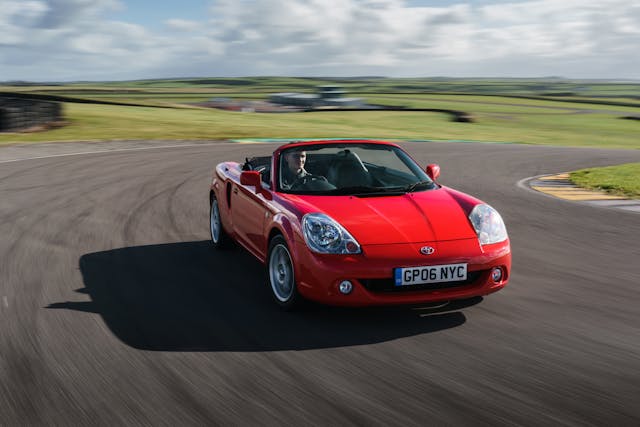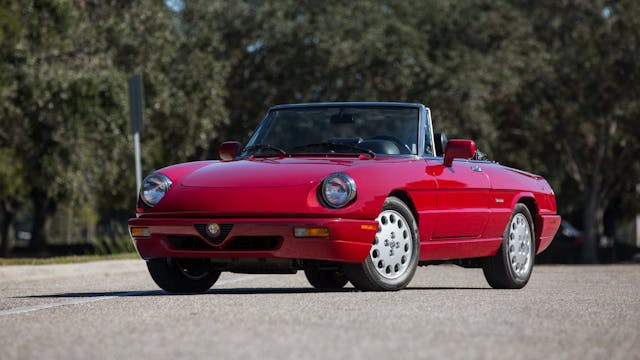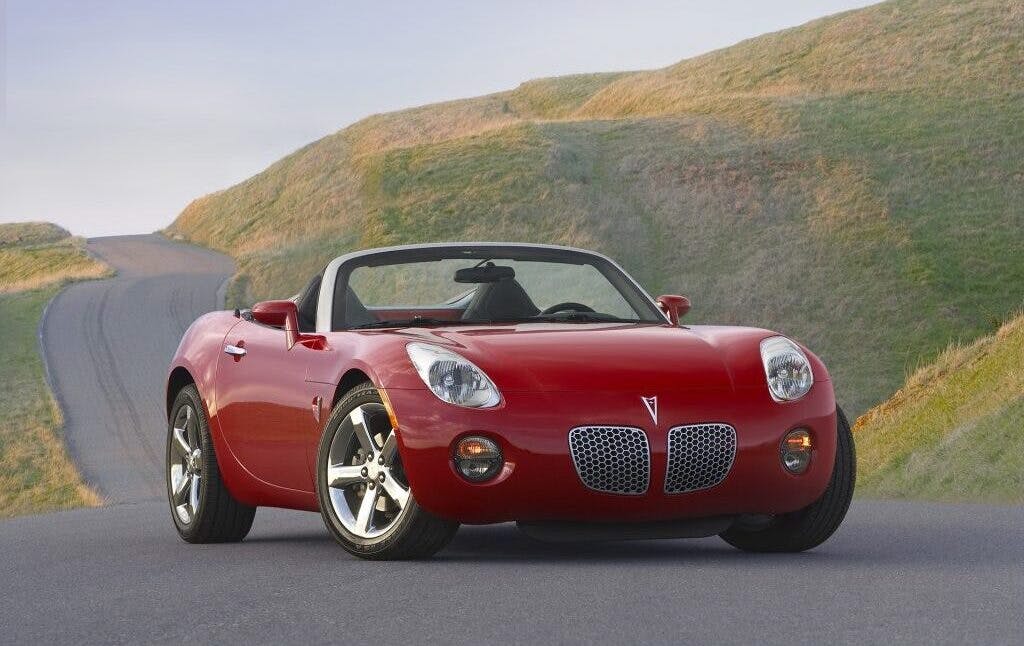For under $25K, these 7 cool convertibles bring fair-weather fun
It’s December now, and for much of the country that means we’re driving with the heater on. Many of us have also put our fun cars away for the winter or are starting to tackle winter projects. It’s never too early to start daydreaming about sunshine and top-down cruising, however, and the two-seater drop-tops below are affordable ways to do it once spring arrives. All are worth under $25,000 in #2 (“Excellent”) condition in the Hagerty Price Guide, but driver-quality examples of each can be found for even less. Which would you pick, or imagine yourself behind the wheel of, when the weather turns warm?
2000-05 Toyota Mr2 Spyder: $20,500

Since Miatas aren’t allowed (we featured them in a recent run-down of popular Japanese collector cars, and everyone knows they’re a viable contestant in this list), why don’t we start with something similar, but then again very different?
In some ways the third (and final) generation Toyota MR2 lives in the shadow of its more interesting, more ambitious predecessors. Taken on its own, though, it offers similar vibe, performance and reliability of the NB (1999-2005) Miata it once competed against. Its 1.8-liter 140-hp four-cylinder has nearly the exact same displacement and power rating as the Mazda, and the two Japanese budget warriors can be had for a similar price.
Then again, the Toyota also comes in a more exotic-feeling mid-engine layout, and because the Mister Two never really caught on (yearly North American sales averaged about one-third of the Mazda MX-5) it’s a relatively rare sight on the road. With its mid-engine mojo and distinctive buggy-eyed face, it’s sort of like a toned-down, more affordable Lotus Elise.
1989-95 Lotus Elan M100: $23,500

Speaking of Lotus (and Miatas), both Mazda and the then-GM-owned British carmaker went into the 1990s with the same idea—basic, affordable English roadsters were long dead, but people would buy one if only somebody would build it. Looking to fill this obvious hole in the enthusiast market, Mazda looked to classics like the MGB and, ironically, Lotus’s own Elan from the 1960s as inspiration. Then they distilled the concept, added Japanese reliability, and drove off into the sunset with what became the world’s best-selling two-seater.
Lotus, however, took a different approach. The new Elan, aka the M100, used a Japanese drivetrain, which was reassuring. With 165 hp from the turbocharged 1.6-liter Isuzu four and a curb weight of less than 2500 pounds, so was performance. But there were two strikes against this new Elan. First was the fact that the Isuzu four spun the front wheels. The Elan M100 has plenty of defenders who will happily tell you how wonderfully it handles, but purists considered a front-drive Lotus just plain blasphemy. Second was the price, which came in at over twice the price of the Miata that launched at the same time. The Elan was significantly faster and came with a much better interior, but it wasn’t enough to justify the cost. Only a few hundred American buyers stepped up for one, so at today’s values they make for a very rare car with a famous premium badge for not a ton of cash.
1986-96 Chevrolet Corvette: $24,600

The C4 Corvette isn’t everyone’s cup of tea, and its values have generally reflected that. But you can’t deny it’s a ton of car for the money compared to the other ’80s and ’90s performance cars that have skyrocketed over the past five years or so.
Technically a C4 coupe is quicker and cheaper than a convertible, and it still offers wind-in-your hair motoring thanks to its removable targa roof panel. Sometimes, though, there’s no substitute for a true drop-top, and C4 convertibles are still remarkably affordable. Aside from the last few model years and special edition models like the Grand Sport or 1995 Indy Pace Car, most L98 (1986-91) and LT1 (1992-96) convertibles can be had for under $25K in #2 condition. If you’re willing to live with some bumps, scratches and miles, however, it gets even better. The #3 (“good”) value for most C4 convertibles doesn’t even push into the teens.
1980-81 Triumph TR8: $23,900

Thinking of a small lightweight English roadster with American-derived V-8 oomph usually brings up the Shelby/AC Cobra or the Sunbeam Tiger. Both of those cars are badass but also downright expensive. There’s another choice, however. One that’s way cheaper and way…wedgier.
In 1975, Triumph started to phase out its old-school TR6 with its body-on-frame construction and wood dash. In its place came the TR7, which was supposed to carry the struggling company into the future. Wedge-shaped cars were all the rage in the mid-1970s, but designer Harris Mann arguably missed the mark with the TR7, which was roundly criticized when new and doesn’t look that great today, either. Early TR7s also had serious reliability issues, and the sub-90-hp 2.0-liter four left them all underpowered. To fix that last bit, Triumph dropped in the all-aluminum 3.5-liter Rover V8 (which traced its roots back to Buick in the 1960s) and christened the new model, naturally, TR8. It was the same basic car, but the much more powerful engine and better build quality were very welcome.
This “English Corvette,” as some called it, was a consistent winner in both SCCA and IMSA racing, while Car and Driver called it “nothing less than the reinvention of the sports car.” But it couldn’t reinvent Triumph. A victim of British Leyland’s collapse in the 1970s and 1980s, the company was defunct by 1984, making the TR8 the last of the traditional British roadsters. Association with the unloved and visually identical TR7 along with the plastic-and-plaid interior kept TR8s cheap for years, and although #2 values are up 52 percent since 2019, these cars still provide good value for the money.
1991-95 Alfa Romeo Spider S4 (base model): $23,400

The original Alfa Spider kept its Italian builders busy for decades, and its 1966-94 production run makes it one of the longest-lasting sports cars ever. It’s also one of a precious few made-in-Italy two-seaters that average enthusiasts can realistically dream of parking in their garage.
The last of the series debuted in 1990 (1991 in the US), and on balance it’s arguably the best of the breed. The looks, chassis, and engine trace their roots straight back to the ’60s, but also featured plenty of upgrades and improvements. In fact, this final generation is sort of like a ’60s classic infused with ’90s comfort and convenience, although some of the older cars’ more interesting quirks were gone. North American buyers could choose from a base Spider or a “Veloce,” featuring luxury add-ons like leather seats, air conditioning, and a cloth top as well as alloy wheels. While Veloce models command a big premium with #2 values stretching past 30 grand, base models come in at a much more tolerable $23,400.
2006-10 Pontiac Solstice/Saturn Sky: $20,700 / $18,600
“Solstice and Sky” sounds like a lady rap duo, but they’re two of the last true American sports cars that don’t read “Corvette” on their tails.
Meant to be home-grown alternatives to the affordable roadsters from Japan, the short-lived Solstice/Sky pair were casualties of GM’s Great Recession bankruptcy. Still, they sold reasonably well when they were around and remain cheap entries into modern roadster fun.
The Pontiac Solstice first arrived for 2006 with 177hp and 166 lb-ft of torque. To bring up the Miata yet again, the Solstice had it beat on grunt, but at 2888 pounds the Pontiac was also several hundred pounds beefier. The interior was also clad in standard early 2000s GM plastic, but the body looked like nothing else on the road, and that’s still the case today. On track it won the SCCA Showroom Stock B and Touring 2 championships, and then in 2007 a hotter Solstice GXP model arrived with 260 turbocharged horsepower and 260 lb-ft of torque as well as a limited-slip diff.
The reskinned Saturn version, called the Sky, arrived for the 2007 model year and its turbocharged variant was called the Redline. All versions of these cars are affordable, but while the Saturn is more conventionally pretty, a Pontiac badge has more cachet than a Saturn one (not a hard thing to do) and is generally worth more. Base Solstices run $16,600 to $19,400 in #2 condition, while a GXP only stretches into the low-20s. The Sky, meanwhile, ranges from $16,400 for a base model to $24,300 for the most expensive Redline.
1997-2004 Porsche Boxster: $22,000

Alas, the “cheap” Porsche is mostly a thing of the past. The 914s, 944s and 996-generation 911s that people used to turn their noses up at have long since gotten respect, and higher price tags as a result. Mercifully, though, the first-gen (986) Boxster, which started at over 40 grand when it was new, has stayed somewhat inexpensive. Sure, it’s not the best-looking P-car, and it has been the butt of many a joke. But you could say the same thing about the 914, and that car’s now twice as expensive as a Boxster.
The 986 is a well-balanced, comfortable, tossable little car. And with one trunk up front and another behind the mid-mounted flat-six, it’s more practical than it looks. In addition to the jellybean styling, the infamous IMS bearing issue tarnished the 986’s reputation a bit, but after two decades many cars have had that issue fixed by now or are unlikely to suffer from it. There are plenty of examples around, and the average #2 condition is $20,800. Stretch the budget a little bit and a Boxster S, which came with a larger engine and over 30 more hp than the base car, sits at just $27K.
***
Check out the Hagerty Media homepage so you don’t miss a single story, or better yet, bookmark it. To get our best stories delivered right to your inbox, subscribe to our newsletters.





You left out the 1996-1997 BMW Z3, the German answer to the Miata. A blast to drive whether the 4 or 6 cylinder. Pretty analog and easy to service, even to the point of a manual top. I’ve owned my 1997 model since 1999 and still love it!
Agree with You on the Z3. We bought our 97 on dealers floor over Christmas in 1996. Car has 36000 mile on it. It has never been driven in the rain nor taken out of the garage between Halloween and March 31. It sits with our 96 Viper GTS,blue and white with 8000 miles. Love them both and neither will be sold
Sad to see no mention of Camaros or Firebirds. My 1994 Camaro Z28 was the first year of the Camaro’s drop down return. Along with the Lt1 made hair in the wind fly.
I had a ’97 Z28 with the LT1 and a ’00 Z28 with the LS1. Liked them both. They were coupes but they both had T-tops. I ran the ’00 car at the local drag strip on several occasions. It was an automatic with 2.73 gears. Best pass was a 13.44 @ 107.5 mph. Pretty decent on street tires.
And those 94 Z/28’s made all the right sounds. Had one back when. Handling and looks to match the great V8 sound track noises……
You forgot to add the four generation of Miatas
I have never seen a ’84 Corvette convertible, is there a picture available?
No. They are as scarce as ’83 Corvettes. First C4 Corvette convertibles were introduced for model year 1986.
Yeah, that would make em fer sure hard to find. Just like the 30th anniversary C3 convertible.
TR8 is the most under appreciated car on this list. Loved my C4, Boxster S and Alfa S4, but the TR8 is a hoot to drive! Lots of support (TWOA and The Wedge Shop aka TWS Motors), and few real concerns… oil leaks and power steering rack are criticized most often.
Try one, you’ll buy one. I did ! Most sell in the teens; you’ll find decent buys under $10k and concours queens run over $20k.
Watch our TR8 video on YouTube channel “Joy Riding”, along with a video visit with Woody at The Wedge Shop to learn more.
True, I loved mine. Like driving a go-cart with a V8. What a blast.
You forgot to include a Model A Roadster to the list. They are more fun than the cars you listed.
My 1929 is all stock. Top speed, 35MPH … when I’m in it. Gets more looks than any other car in my community.
Hagerty continues to ignore the Jaguar XJS convertible. That’s good because it keeps their acquisition price low. Bad because the acquisition price is low. Value’s haven’t increased much. I own a 1993 XJS and enjoy driving it. The Jaguar 12 cylinder engine has had a bad reputation for years. This may be part of why XJSs remain undervalued. Mine is a 4 liter version with 108K miles on it. Again it runs great. I take it on 500+ road trips a few times a year. It is a ‘93 so repairs and maintenance are necessary. Last repairs were for one leaking rear shock, replacing the transmission cushion parts ( mine is a 5 speed) repairing a squished gas line under the car. Not too bad considering the age and miles on the car. So, if Hagerty continues to ignore the Jaguar XJS and if my buddy Wayne Carini doesn’t buy one on “Chasing Classic Cars”, the XJS convertible will remain affordable. Go get one. And, there are still repair shops to help keep them on the road. JV
Did you forget? The answer is always Miata!
If you don’t mind getting dusted at every traffic light get a miata.
“The Race is Won in the Curves.”- F. Porsche
Straight lines are a snore. So are overpowered, nose heavy cruisers.
It’s better and more fun to drive a slow car at 7/10s than a fast car at 3/10s.
I was going to comment on a few of the cars not mentioned, but my voice would be lost in the chorus. There must be a dozen BMW models alone! various Z3’s, Z4’s, 3 Series, heck even the 6’s can be found at your price point.
With so many great choices, can we please take that sorry excuse for an Elan off the list?
I special ordered a ’98 Boxster new. Waited 5 months for it. Loved it–at first. From the beginning the ceaseless trips to the dealer began: countless warning lights; failed sunvisors, one at a time; creaks and groans; the top lid hinge failed and warped the lid into a potato chip-shaped mess. At last the engine blew up on start at the supermarket. Porsche bought the car back under the Lemon Law–100%. When I returned the car, the salesman assured me, “You’ll be back…” Ha! Never, jamais. I can’t imagine Boxsters have improved with age. Today I drive 3 old Corvette convertibles: a C2, C4 and C5.
Funny how the author compares most of these to the Miata but doesn’t include the Miata.
Everyone comments on the “missing” Miata. Read the article! It says in the first few paragraphs that the Miata would obviously be on the list, but these are other fun alternatives that are available for the price.
A well bought S2000 (stock) is so much fun, reliable and should appreciate over time. I bought my 2003 in 2012, one day before Sandy hit NJ. Where it was ended up under 8 feet of water. It has appreciated nearly 3 times what I paid.
I like the TR 8s /TR 7s styling. As examples of that wedge shape that was then popular they appeal to me. In contrast the C4 looks, in a word, bland. It strikes me odd that while you say ” doesn’t look that great today, either ” The Testarossa is described in ‘ The Bull Market List’ as having been a ” brash new car ” with a “face-slapping effect. Okay maybe, but doesn’t that necessarily mean attractive? They called those side vents ‘ cheese graters’ for a reason and it wasn’t a compliment. Much like every great artists pieces aren’t home runs not every Pininfarinas designs aren’t either. I’m not hearing choruses of praise for the Mondials that shared those kitchen mandolin slicer inlets. Not to mention that the V-8 is all ‘al-u-min-e-um ‘ and weighed less than many six and even four cylinders at that time. Something to be said for that. British Leyland spent a considerable amount of time and effort making it reliable. Besides there’s something to be said about being the only lad on the block to have one.
Miata schmiata! I would rather drive my S2000 over one of those anytime! And sorry folks, but Corvettes of that more classic design are a dime a dozen.
Absolutely right. Don’t know how the S2000 continues to be overlooked in enthusiast circles.
Mgb the car that started all of this list.
Had one ten years, repairs; radiator hose & alternator. $5k